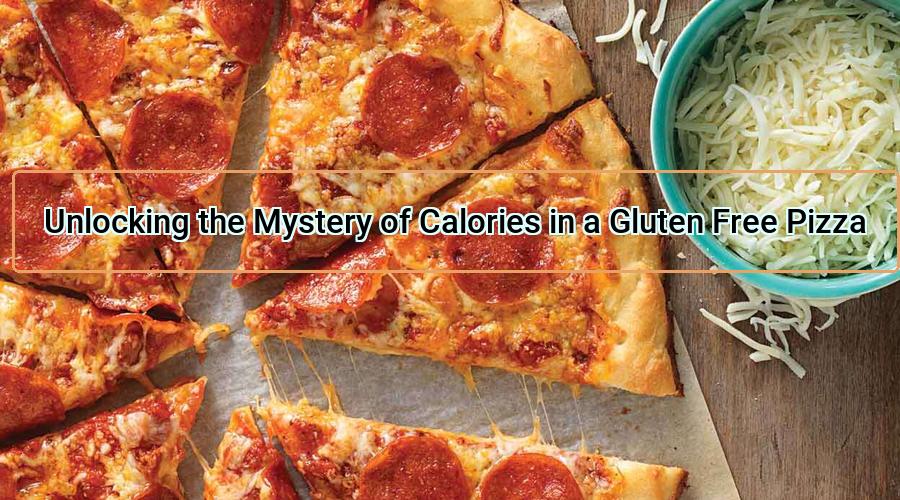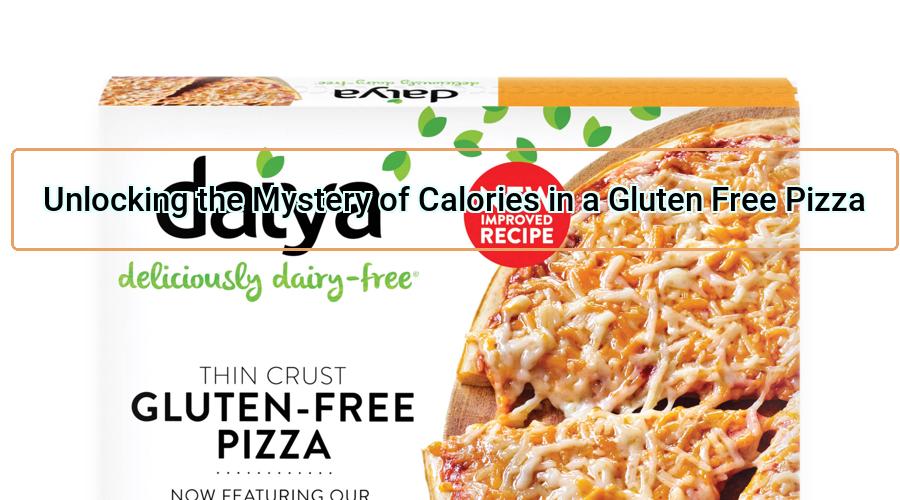Eating gluten-free does not mean you have to give up on all your favorite foods, especially pizza. Although finding a gluten-free pizza can be difficult, there are a few brands that make delicious options for those with dietary restrictions. But how many calories are in a gluten-free pizza? That’s what we’re here to uncover.
By breaking down the ingredients and looking at the nutrition labels, we can unlock the mystery of calories in a gluten free pizza. To start, it’s important to note that different brands of gluten free pizzas have varying calorie counts — some may be lower than traditional pizzas while others may surprisingly be higher. Depending on the type of crust and toppings used, this could affect its nutritional value greatly.

Gluten Free Pizza: What You Should Know about Calories
Gluten free pizza is becoming increasingly popular as people continue to search for healthier alternatives. Whether you’re avoiding gluten due to a medical condition or simply want to reduce your intake, it’s important to be aware of the nutritional content of your food choices. When it comes to calories, there are a few things that you should know about gluten free pizza.
First, many gluten free pizzas have fewer calories than those made with traditional wheat-based dough. This is because wheat flour contains more carbs which adds additional calories. Second, if you make your own gluten free pizza at home using alternative flours like almond or coconut flour, the calorie count may be higher due to the higher fat content in these ingredients. You can also use cauliflower crust for an even lower calorie option!
Calorie Conscious: Decoding Gluten Free Pizza Nutrition
Gluten-free pizza may be a popular menu item, but that doesn’t necessarily mean it’s the healthiest choice. With pizza easily surpassing 500 calories per slice, it is important to get creative with your gluten free options. Decoding nutrition labels and ingredient lists can help you make smart decisions when choosing a gluten-free pizza option.
By reading the nutrition label of your favorite brand of gluten-free pizza, you can determine exactly how many calories are in each slice and if other ingredients like sugar or sodium are high. Keeping an eye on portion sizes is also key for maintaining a healthy diet and avoiding overindulging in calorie dense food items. For example, one large slice of gluten-free pizza can contain upwards of 350 calories or more depending on toppings used.

Gluten free pizza has become a popular choice for those looking to enjoy a classic comfort food without the worry of gluten-based ingredients. But does going gluten-free mean the pizza is healthier? Deciphering nutrition labels on store bought and restaurant-style gluten free pizzas can be tricky, but with some careful calculations, you can make an informed decision about your meal.
Gluten-Free & Calorie Count: What’s Inside Your Pizza
In this day and age, many people are focused on health-conscious eating. Whether you are gluten-free or watching your calorie intake, pizza can still be a part of your diet. Before you indulge in that delicious slice, though, it’s important to know what ingredients are inside. Gluten-free and calorie conscious pizzas can vary greatly in terms of offerings and nutritional information – each slice may have different components depending on the recipe used by the pizza maker. It’s essential that consumers understand these differences so they are able to make an informed decision when selecting their pizza of choice. By breaking down the ingredients and analyzing calories for each topping available, individuals can decide which type of pizza will fit into their nutrition plans without sacrificing taste.
Cut Calories with Gluten Free Pizza
There’s nothing quite like a slice of pizza for a quick lunch or dinner. But if you’re trying to lose weight, regular pizza can be loaded with empty calories. Gluten-free pizza is a great way to enjoy the flavor and texture of your favorite food without all the extra fat and carbs. Plus, it can be just as delicious as the traditional version!

If you’re looking for an easy way to cut calories from your diet, gluten-free pizza could be the perfect solution. Not only does it taste great and provide plenty of flavor, but it can also be made with healthier ingredients such as fresh vegetables, lean meats, and low-fat cheeses. And because there are so many different varieties available on the market today, you can easily find one that fits your dietary needs and preferences.
Surprising Nutritional Content in Gluten Free Pizzas
Gluten free pizzas may sound like an oxymoron, as pizza is normally associated with wheat flour. However, many companies are now producing delicious gluten free pizzas that provide a range of essential nutrition in every bite. Gluten free pizzas have surprising nutritional content that can benefit both those who have celiac disease and anyone who wants to get more nutritious food into their diet.
Gluten free pizzas contain several key vitamins and minerals, such as calcium, iron, zinc, magnesium and folate. They also tend to be low in sodium and saturated fat compared to regular pizza. In addition to containing essential nutrients for health maintenance, many gluten free pizza crusts are made with whole grain flours that are high in fiber. This helps keep you feeling full longer while providing the body with energy-boosting carbohydrates.
Nutritional information for a gluten free pizza
For those looking to enjoy a delicious pizza while following a gluten-free diet, there are now more options than ever before. Gluten free pizzas offer an excellent way to get all the flavors of a traditional pizza – without the gluten. But with so many different varieties and brands, it can be difficult to know the nutritional information for each type of pizza. Here is what you need to know about gluten free pizzas and their nutritional content.
Gluten free pizzas vary greatly in terms of calories, fat, sodium, carbohydrates, and protein levels depending on brand and ingredients used. Generally speaking however, most gluten free pizzas contain significantly fewer calories than their regular counterparts – often 200-300 calories less per serving – making them ideal for those looking to watch their calorie intake.

Ingredients in a gluten free pizza
For those looking to indulge in pizza without the gluten, there are plenty of delicious options available. Gluten free pizzas can be made at home with a few simple ingredients, or store-bought for convenience. To create a homemade version, you will need gluten free flour, yeast, olive oil and other typical pizza toppings like cheese and marinara sauce.
Gluten free flour is essential for making a crust that’s both flavorful and sturdy enough to support your favorite toppings. Look for an all-purpose blend specifically labeled as “gluten free” to ensure no wheat products were used in its production. Yeast adds flavor and helps the dough rise properly so it’s light and fluffy rather than dense and chewy. Finally, a drizzle of olive oil binds the ingredients together while adding richness to your finished pie.
How do I make a gluten free pizza?
Making a delicious gluten-free pizza can seem like an intimidating task, but with just a few ingredients and a bit of know-how it can be done! Whether you have dietary restrictions or are simply looking to try something new, this article will provide you with all the information needed to make your own gluten free pizza. We’ll discuss which ingredients to use, how to prepare them, and the best way to cook your pizza for maximum flavor and texture.
How many calories are in a gluten free pizza?
When people are trying to eat a healthier diet, gluten-free pizza is a great alternative. However, it is important to understand how many calories are in this food option before making it part of your meal plan. This article will provide an overview of the nutritional facts related to gluten-free pizza and answer the question: how many calories are in a gluten free pizza? Furthermore, we will discuss factors that can affect calorie counts and offer tips on how to choose the healthiest pizza available.
What is the nutritional value of a gluten free pizza?
Gluten free diets are becoming increasingly popular in recent years, due to the perceived health benefits which come with removing gluten from one’s diet. But what do we really know about the nutritional value of a gluten free pizza? Gluten-free diets have been linked to improved digestion and better overall health, but it’s important to consider the other components that make up a gluten-free pizza before deciding if this food is right for you.

